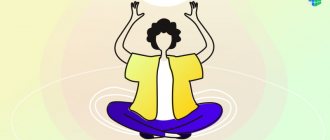Ataraxia is complete peace of mind and equanimity, a certain composure, serenity, which is not part of the personality or a feature of temperament, but a state achieved by a sage during his life. The concept of ataraxia was introduced by ancient Greek philosophers, then with the development of other directions, the concept deepened more and more, received shades and its own specific interpretations, without departing from the main line.
Ataraxia is a concept not only of philosophy, it has passed into all sciences relating to the human psyche, as a doctrine of the soul. This term is considered not as a life concept, but as a personal quality by psychology, but as a set of symptoms by medicine.
Brief Definition
So, ataraxia is a definition of behavioral qualities of a person, which is characterized by a complete absence of fear, worry and anxiety. In other words, a person who is in this mental state behaves extremely calmly, insensitively, impartially. Both negative and positive emotions are alien to him, therefore he completes any work, any task he has started, as if in one breath, without changing his mood, technically and impartially. It is worth noting here that only now this term is used exclusively by psychologists, characterizing the mental state of their clients. Previously, he was related exclusively to philosophical teachings, and therefore his history is extremely interesting.
What it is
The literal meaning of the word ataraxia is equanimity, which is a direct interpretation and translation from Greek. Initially, the concept was a noun denoting a process; later, thanks to Aristotle, it acquired the meaning of an adjective. Usually, ataraxia is considered as a personality quality, classified as a virtue and characterizing not so much indifferent apathy as a person’s courageous restraint, his ability to restrain his own emotional reactions and objectively, a little distantly, evaluate what is happening.
If we take the psychological component of ataraxia, it implies a lack of fear associated with severe stress experienced. Those. it is not a lack of sensitivity, attentiveness and self-preservation instinct, but knowledge and reactions built on the events of past experience. Psychological defenses can work here as a way to protect the psyche from even greater experiences after terrible events, but with a high degree of awareness, this is about the conclusions drawn and acquired adaptive strategies of behavior.
Any interpretation of ataraxia must occur separately from similar concepts of indifference or apathy, which manifest themselves in a similar way to an external observer who has not really delved into the differences. There is no complete alienation to everything; what is happening around is important to a person, but due to the events he has experienced, he has received great calm in the face of changing events. This is comparable to people who went through a war and survived there - they don’t care whether their loved ones are sick or whether their cities are destroyed, but they do not panic, but calmly make cold-blooded decisions for a different development of events.
The origin of the word
Ataraxia in philosophy is, first of all, peace of mind, serenity, composure and equanimity. Conditions that could only be achieved in their mature, or even in their old years, by the wisest philosophers and healers of the ancient world. The word itself originated around the fifth century BC, and Democritus of Abdera is considered its “father”. However, in his writings a specific description of this mental state occurs only occasionally. In subsequent years, Aristotle began to develop this topic. In his concept, ataraxia is like a special definition of virtue. With this term he denotes such qualities as courage, restraint and dispassion.
Ataraxia in ancient teachings
During the period of prosperity of ancient philosophy, this term became very widespread in such movements as skepticism and Epicureanism. Some researchers also believe that ataraxia in philosophy is precisely the starting point that made it possible for these teachings to develop, because they are essentially based on it. Skepticism teaches us that we should pay attention, first of all, to facts. There is no need to be distracted by various hypotheses, reflections and other nonsense. Only with the help of proven material, objects that can be seen and touched, reality is built. In Epicureanism, ataraxia is the basis for receiving pleasure. Slaves and women came to the philosophical school, which was founded by Epicurus. The basis of the teaching for this stratum of the population were the following dogmas:
- No fear of the gods.
- No fear of death.
- The benefit can be easily achieved.
- Evil can be easily survived.
School of Stoicism
Concepts such as apathy and ataraxia are closely related to the doctrine called “stoicism,” which appeared in the Hellenistic era and lasted until the fall of the Western Roman Empire. In earlier years, these terms were not fundamentally different, and the words were considered synonymous. Later, ataraxia began to be called the ability to behave with restraint, coolness and prudence, making the right decisions. Marcus Aurelius, in turn, believed that such psychic abilities appear in a person after he has experienced certain events and encountered difficulties that made him more callous and sensible. It is worth highlighting here that it is on the basis of his teachings on this matter that all the developments of modern psychologists are based.
Face lift
Let's look at several options for procedures for correcting the lower third of the face and eliminating asymmetry.
Lipolitics
The procedure for modeling the face using lipolytics is called injection lipolysis. Lipolitics are preparations based on natural ingredients, their main action is aimed at the breakdown of subcutaneous fat cells, resulting in a rejuvenating effect.
The effect of the procedure with lipolytics occurs quite quickly, the oval of the face changes, and the subcutaneous tissue structure is aligned. The procedure does not allow the splitting of an extensive layer of fat.
In what cases are lipolytics used?
- if you need to eliminate a double chin,
- form a natural oval face,
- reduce the volume of the cheeks,
- eliminate defects in the shape of the nose,
- correct nasolabial folds
Cost per 1 ml
procedures vary
from 3 thousand rubles
and more, depending on the drug, the number of milliliters administered and the number of correction zones. For a pronounced effect, you need at least six to eight procedures for each zone, which involves serious expenses, reaching 200 thousand rubles and even higher.
The lifting effect is temporary. After some time, the procedure is usually repeated.
Mesotherapy
Mesotherapy consists of therapeutic injections of individually selected cocktails, which are injected into the middle layer of the skin with a very thin needle.
After the mesotherapy procedure:
- complexion improves,
- muscle tone increases,
- you can eliminate “creases” in the skin,
- you can remove nasolabial folds and drooping corners of the lips,
- You can remove your double chin.
The number of rejuvenating procedures during mesotherapy depends on the age and problems that need to be eliminated. Mesotherapy has a cumulative effect, the results of the procedures can be seen in 2-4 weeks. On average, 5 to 7 procedures are required with an interval of 1 time per week; if necessary, the cosmetologist can increase the number of mesotherapy procedures. The cost of the procedure varies from 4000 - 5000 rubles
and higher in one procedure.
Mesotherapy effect
- temporary. To maintain the effect, the procedure must be repeated once every 6-12 months.
Biorevitalization - 3D face lifting with hyaluronic acid
The biorevitalization procedure is currently the most popular. We all know well, according to doctors, that the main property of hyaluronic acid is to retain moisture, maintaining the natural hydrobalance of the skin.
Biorevitalization is carried out in all areas where there are problems - on the face, neck, décolleté, and is also used in other areas of the body, providing the necessary hydro reserve to the skin layers. Injection biorevitalization is comparable in effect to a surgical facelift; the procedure can completely sculpt the face.
Using hyaluronic acid injections, you can correct the lower third of the face:
- remove pronounced nasolabial folds,
- remove flaws, if any, on the chin, that is, change its shape,
- and also adjust the profile along the lower jaw.
Cost of biorevitalization.
The cost of injections depends on the drug used, its density and the number of milliliters required for the procedure. For example, for visual correction of malocclusion (the area under the chin), you may need up to 4 ml of the drug, the cost of 1 ml is from 18-20 thousand rubles. The general course can range from 1 to 5 procedures at intervals.
The effect of biorevitalization
- temporary. After the procedure, there is an immediate, pronounced visual effect that lasts from 5 to 12-15 months; to maintain the effect, the procedure must be repeated.
Kogi threads
Cog mesothreads provide a clear oval face and a pronounced lifting effect. Installed mesothreads contribute to the formation of dense connective tissue, and also help to activate the production of collagen and elastin, which are responsible for skin elasticity.
Kogi threads have notches, thanks to which it is possible to achieve:
- pronounced lifting effect,
- clear contour, tightening of soft tissues and prolonged action of thread lifting,
- They perfectly hold the given shape of problem areas of the face or body.
You may need 4-6 threads for the whole face, the average price is from 5 - 15 thousand rubles for 1 thread.
Effect of the procedure
- longer lasting, but also temporary. Kogi threads have a prolonged effect, the result of the procedure lasts from 2 to 4 years, to maintain the effect the procedure must be repeated.
From a medical point of view
In contrast to ancient philosophers, modern psychologists perceive the term “ataraxia” in a completely different context. A disease, a disorder, a deviation, which is often acquired - this is how ataraxia is characterized these days. Most often it is covered by psychologists as an intermediate phenomenon in human behavior. On the one hand, ataraxia manifests itself as a consequence of severe stress. The body, enclosing itself within the framework of restraint, composure and indifference, protects itself from further emotional shocks. If ataraxia is achieved in this way (and not artificially, through spiritual practices), then it can have very serious consequences.
Features of donating a dacha
Dachas are real estate that is most often located on garden and summer cottage plots. The owner has the right to gift it to any person if the appropriate documents are drawn up.
A dacha refers to two independent real estate objects: a plot and the buildings located on it. They are alienated at the same time; donation separately is unacceptable (Article 35 of the Land Code of the Russian Federation).
There are two parties involved in donating a dacha – the donor and the recipient. The first (owner) transfers the property to the second under an agreement free of charge. Presentation of counter conditions for the transfer of money or provision is prohibited by Art. 572 of the Civil Code of the Russian Federation - other rules of a civil law nature apply to such transactions.
Important! The gift agreement (hereinafter referred to as the DD) can be multilateral. Free alienation of real estate from one donor to several donees is allowed, and vice versa
If the land plot is not registered as a property, there is no information about it in the Unified State Register of Real Estate, then the deal will not be concluded. Before signing the deed of gift, you need to draw up all the documents, and only after that agree on the donation with the donee.
What does this disease mean?
Many modern researchers are often interested in the question of what ataraxia and aphasia are together and how these concepts are related to each other. So, a mental disorder such as ataraxia, if acquired naturally (a consequence of stress), can lead to more serious disorders in the functioning of the brain. The most famous case is considered to be aphasia - a speech disorder due to damage to the functioning of neurons in the left hemisphere of the brain. It is worth noting that the functioning of the speech apparatus remains healthy. Syntactic norms of speech, morphological or phonemic may be distorted.
Causes
So, we have found that ataraxia occurs in cases where a person is exposed to severe stress or experiences psychological trauma. It is also a consequence of taking certain groups of medications. But there are other factors that provoke its development:
- Persistent depression.
- Professional activities associated with excessive emotional stress. Over time, it leads to burnout and even apathy.
- Restraining negative emotions over a long period of time, preventing their manifestation.
Organic brain damage can also be added to the list.
We achieve our cherished goal
For many sages of the past, as well as for many people of our time, ataraxia was one of the most interesting topics in psychology and philosophy. How to achieve such a state, how to stay in it constantly and not injure yourself? Let's try to figure this out. We have already decided that such a condition can be a consequence of stress. In this case, ataraxia will be considered a disease, a deviation.
It’s a completely different matter if you yourself, as it were, lower yourself into a pool of serenity, impartiality and calm. You will have to practice for years, perhaps based on some mistakes and life experience. With the right attitude and desire, you will gradually become more thoughtful and cold towards little things. Attention will be focused only on the most important, and soon the worldview will radically change.
Description of the development of the state of apathy
Philosophy considers the concept of “apathy” as one of the types of ataraxia. More precisely, different philosophical schools and movements characterize the concept of mental balance and the ideal of harmony in relation to their beliefs. The state of apathy is most associated with the Stoics. Their concept of happiness is based on something else - correct desires and actions, dividing things into good and evil. However, it was the Stoics who considered apathy a virtue, and the later Stoics, represented by Seneca, defined “insensibility” as the ability to control oneself.
The development of apathy occurs due to following the chosen ideal of cultivating inner strength. A person gets rid of unnecessary fear, anxiety and dependence on opinions. But achieving a high level of self-control does not indicate a rejection of generally accepted moral standards or denial of submission to the laws of the country and society. On the contrary, the state of ataraxia develops as a transition to a higher degree of prudence, awareness and calm, based on intellectual strength.
Practices of ancient sages
In order to independently achieve the state of ataraxia, first of all, you can use the so-called commandments of Epicurus, since they are focused on obtaining asocial pleasure, which is closest to a person. So, the bottom line is this: to achieve happiness, a person needs to avoid bodily suffering. At the same time, his soul must remain in complete weightlessness. There should be no love, no hatred, no other feelings in it. In the end, a person will need friendship with like-minded people who can share his point of view and philosophy. It will also be a very useful practice to refuse to perceive mutually exclusive concepts, such as grief-joy, beauty-ugliness, life-death, etc. But it is worth realizing that there is no such thing as truth. Everyone has their own, and everyone has a personal point of view and judgment.
ATARAXIA
(Greek ἀταραξία, ἀ – negative particle + ταραχή, excitement, confusion, anxiety) – a term of ancient ethics, meaning “equanimity”, “serenity”.
The most general meaning lies in the ideal of the soul's insensitivity to affects, the transfer of attention from external circumstances to the internal state and the preference of reason to feelings - an understanding shared by almost all ancient schools; The term acquired its greatest significance in the ethics of the Epicureans and Skeptics. For the first time, the noun α̕ ταραξία appears in Democritus: “he calls happiness the complacency (εὐθυμίη) of the spirit, and well-being, and harmony, and regularity, and serenity-ataraxia” (fr. 742 Lurie = Stob. II, 7, 31, p. 52, 13 W) and “wisdom, undaunted equanimity - ataraxia - above all” (fr. 743 = Stob. III, 7, 74), - cf. another neologism of Democritus is “fearlessness” (αϑαμβίη), with which ataraxia is close and in the subsequent tradition supplants it. For the history of the concept, the use of the adjective “unperturbed” (ἀ τάραχος) by Aristotle in the definition of such virtues as πραότης (evenness of character, restraint) is important: “a restrained person tries to remain unperturbed and obey not feelings, but follow reason” (Eth. Niс. 1125b34 ), and ἀ νδρεία (courage) (see Eth. Niс. 1117al8.31). Aristotle's understanding of the "equanimity" state as a state of subordination of the senses to reason (the formula for all virtue), together with the Democritus' concept of ataraxia, influenced the Epicurean "equanimity" - probably through the atomist Nausiphanes, a student
of Pyrrho and teacher of Epicurus (cf. his neologism "equanimity" "(ἀ καταπληξία) instead of Democritus' "fearlessness").
In addition, Epicurus studied with Xenocrates
, for whom the use of the cognate word “outrage” is attested in an important context: the reason for practicing philosophy is “to put an end to disturbances in our lives about things” (fr. 4 Heinze).
In connection with Pyrrho, the doxographic tradition records ataraxia as a colloquial metaphor to describe the state of mind of a true sage: “On a ship during a storm, when his companions fell into despondency, he (Pyrrho) remained calm and encouraged them, pointing to the ship’s pig, which was eating for itself and ate, and saying that a sage should abide in such serenity-ataraxia” (Diog. L LX 68). In the traditions of school Pyrrhonism (Aenesidemus – Timon – Sextus Empiricus) and academic skepticism (Arkesilaus), ataraxia is consistently associated with the term “abstention from judgment” ( era
),
–
Moreover, Sextus Empiricus calls ataraxia the final goal, and Diogenes Laertius and Arcesilaus (Sext. Emp. Pyrrh. I 232.8) - the era: “Skeptics consider the era to be the ultimate goal, followed by ataraxia like a shadow” (Diog. L. IX 107) ; “An era is a stop of reasoning (στάσις διανοίας), when we deny nothing and affirm nothing; and ataraxia is serenity and tranquility of the soul (ψυχής ἀ οχλησία καὶ γαληνότης)”, “ataraxia comes with the era” (Sext. Emp. Pyrrh. I 10, cf. also I 31: “ataraxia follows the era”). That ataraxia describes a state of mind (= rational soul) and not of the senses is shown by the distinction between ataraxia and metriopathy (“moderation”, a term originally peripatetic) as ultimate goals: “In that which is subject to (evaluative) opinion, the goal of the skeptic is ataraxia , but what we are forced to experience is metriopathy” (ibid., I 30, 7; cf. I 25, 4–6). This means that the skeptic, like all people, experiences feelings of pleasure and pain, but he does not make dogmatic judgments about whether this is good or bad. Sextus Empiricus demonstrates the paradoxical nature of the connection between ataraxia as a goal and the era as a means of achieving it with the help of a pictorial metaphor: “They say that he (the painter Apelles), while painting a horse and wishing to depict the foam of a horse in the picture, suffered such failure that he abandoned it and threw a sponge into the picture, which he usually used to remove paint from a brush; and the sponge, touching the horse, produced a semblance of foam. So the skeptics at first hoped to achieve ataraxia by judging the discrepancy between the visible and the conceivable; but finding themselves unable to do this, they refrained from judgment, and the consequence of their abstinence was, as if by chance, ataraxia, like a shadow behind the body” (ibid., I 29). Just as among the skeptics ataraxia was associated with the era (“after the era follows ataraxia”), so with Epicurus ataraxia is associated with “pleasure” (ἡδονή). In the ethics of Epicurus, the ultimate goal is “pleasure,” negatively characterized as the absence of bodily pain and mental turmoil (μήτε ταράττεσθαι κατὰ ψυχήν) (Diog. L. X, 131, 8–11), sometimes mental ataraxia is directly called the “ultimate goal” ( ibid., X 128, 3–4) together with “bodily health.” At the same time, Epicurus considered mental pleasures higher than bodily ones and associated them with virtues and reason. Anxiety in the soul arises primarily from false opinions about the gods and about death, which evoke a feeling of fear in people - “sober reasoning” eliminates false opinions and leads to ataraxia (cf. ibid., X 132); the state of ataraxia is a concentration on “the most general and important” (X 82). Like the skeptics, the Epicureans viewed the natural sciences only as a propaedeutic to ethics and, accordingly, a means to achieve ataraxia (cf. Sextus Empiricus: “We touch the natural sciences for the sake of ataraxia,” Pyrrh. 118; Epicurus: “The ultimate goal of the study of celestial phenomena, as and everything else, is ataraxia and firm certainty (πίστιν βέβαιον)" Diog. L. X 85), however, the paths to this ataraxia were different for the two schools: the Epicureans offered “a variety of explanations” (ibid., X 100) for sensory phenomena, skeptics refrained from making judgments about phenomena. According to Epicurus, “whoever struggles with evidence will never be able to achieve true ataraxia” (ibid., X 96). According to the Epicurean ideal of ataraxia, all sciences turn out to be indifferent to happiness, and this is polemically directed against the Aristotelian understanding of happiness as inextricably linked with theoretical virtue.
Among the Stoics, ataraxia is often used in a meaning close to apathy
.
M.A. Solopova











